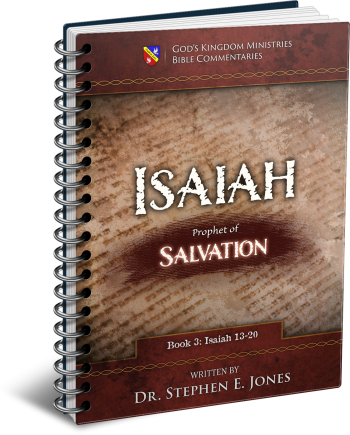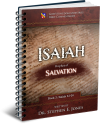Latest Posts
View the latest posts in an easy-to-read list format, with filtering options.

Isaiah is the prophet of Salvation. He is also known as the truly "Universalist" prophet, by which is meant that He makes it clear that salvation is extended equally to all nations and not just to Israel. He lived to see the fall of Israel and the deportation of the Israelites to Assyria, and he prophesied of their "return" to God (through repentance). He is truly a "major prophet" whose prophecies greatly influenced the Apostle Paul in the New Testament.
Category - Bible Commentaries

Speaking of Babylon, specifically its king, Isaiah 14:13-15 says.
13 But you said in your heart, “I will ascend to heaven; I will raise my throne above the stars of God, and I will sit on the mount of assembly in the recesses of the north. 14 I will ascend above the heights of the clouds; I will make myself like the Most High.” 15 Nevertheless, you will be thrust down to Sheol, to the recesses of the pit.
The king of Babylon, in his arrogance, did not recognize the sovereignty of God but thought that his kingdom was invincible and that he and his dynasty would rule the world forever. Many kings have thought this, but in the end their kingdoms fell and their kings went to Sheol.
The prophet’s terminology has caused many to believe that he was speaking about “Lucifer” or Satan as the spiritual ruler who was using the arrogant king of Babylon as his proxy. In other words, they have detected an underlying layer of meaning, where there was truth on more than one level.
They see a similar reference to Lucifer in Ezekiel 28:2-10, which is a prophecy against the city-state of Tyre and its arrogant king, who likewise said, “I am a god.”
In both cases, however, the prophets put them in their place. Ezekiel 28:2 says, “Yet you are a man and not God.” Isaiah 14:16, 17 says,
16 Those who see you will gaze at you, they will ponder over you, saying, “Is this the man who made the earth to tremble, who shook kingdoms, 17 who made the world like a wilderness and overthrew its cities, who did not allow his prisoners to go home?”
Hence, there is no doubt that the prophets were speaking primarily of earthly kings. Even so, in my experience, I have seen earthly events repeat spiritual patterns.
A biblical example is found in Revelation 12, where the “red dragon” is said to be cast down by Michael, the archangel, while attempting to devour the child of the woman clothed with the sun. This heavenly pattern, pictured in the constellations of Virgo and Draco, played out in the time of Christ’s birth in Bethlehem. The earthly event pictured Mary and the Christ Child being threatened by King Herod, the Edomite king of Judah. Edom means “red.” One might say that Herod was the earthly proxy for the spiritual king, “the great dragon… the serpent of old who is called the devil and Satan” (Rev. 12:9).
To claim just one level of interpretation on such passages is to remain blind to spiritual events going on in the warfare seen in the second heavens, which stands between the first heaven in our physical dimension and the third heavens, where the throne of God is. While there are wars on earth between kings and nations, there are also wars in the heavens. Heavenly events set patterns for earthly events.
The prophet Daniel was given revelation about such wars in Dan. 10:13, 20. There we see how spiritual “princes” claiming jurisdiction over earthly territories fought heavenly battles without the awareness of most men on earth. The outcome of heavenly wars then determined the course of earthly events, for all things happen in the spiritual realm before they occur in the earth. To change earthly conditions or events, one must change the corresponding heavenly condition or alter spiritual events.
For this reason, it is not unreasonable to see a deeper level in Isaiah’s prophecy of the king of Babylon. This has brought about the common view that in the distant past, an angel named Lucifer, filled with arrogance, attempted a coup against God Himself. Having lost that battle, he and a third of the angels in heaven were cast out (Rev. 12:4). These remained in the second heaven, where the war has continued to the present time, each generation having opportunity to engage in spiritual warfare to affect the earthly events in its own time and for the future.
Scripture does not contain any dissertations on this that might solidify such teachings, but there are enough hints here and there to let us know of the reality of spiritual warfare. Most knowledge of such things, then, comes through revelation in the midst of actual earthly experience.
Isaiah 14:13 puts words into the mouth of the king of Babylon and his spiritual counterpart, saying, “I will ascend to heaven, I will raise my throne above the stars of God, and I will sit on the mount of assembly in the recesses of the north.” His stated intent is similar to that of the original Babylonian king in Gen. 11:3, 4, who said, “Come, let us build for ourselves a city and a tower whose top will reach into heaven.”
God took it seriously, for it was much more than just an attempt to build a high tower. It was a seven-stepped pyramid on whose top was a temple with a green-glass dome from which it was said that men would spring into the heavens.
This tower was duplicated, as best they could, in Arizona when Neal Frisbee built his “Capstone Cathedral” in 1968. He claimed that the “rapture” would take place from that location, where men would spring into the heavens.
His inspiration was questionable at best, for he deliberately followed the Babylonian pattern of the Tower of Babel, complete with a green-glass structure on the top of his stepped pyramid.
The “mount of assembly” in Isaiah 14:13 is the mount of mo-ed, which is more than an assembly. It was an appointed time, an early word that later became known as a feast day in Israel. Hence, the king of Babylon usurped the authority to set the appointed times, because the feast days are the appointed times for prophetic events to occur.
For example, the appointed time for Passover was when Jesus had to die on the cross. The appointed time for Pentecost was the day that the Holy Spirit descended in Acts 2. In the appointed time of the second coming of Christ, the feast of Trumpets will be the day of resurrection, and the feast of Tabernacles will see the change from mortality to immortality, the coming of Christ, and the presentation of that perfected body of Christ to the Father on the eighth day of the feast.
The arrogance of the king of Babylon and his spiritual ruler attempts to take the place of God, to set new times, and to change the rules for the fulfillment of these prophecies. The Capstone Cathedral is a perfect example of this, for it was built upon these attempted changes. Specifically, the feast of Tabernacles and its prophecies were altered to fit men’s concept of the “rapture.” Tabernacles is about the presentation of the sons of God on the eighth day, but the “rapture” sets forth men’s ideas and puts the prophecies of Scripture into a different context. This causes much misunderstanding of the word of God.
See my book, The Rapture in the Light of Tabernacles.
In times past, when I was actively engaged in spiritual battles, I occasionally saw opposition from Christian ministers who had been deceived into thinking that they were fighting on God’s side. These were identifiable because in the spirit they wore robes and clerical collars. These were much more difficult to overcome than mere evil spirits, because as men created in the image of God, they had much greater authority in spiritual warfare.
When Nimrod founded the city of Babel, or Babylon (Gen. 10:9, 10), the North Star was Thuban, a star in the constellation of Draco, the dragon. It appeared to be the hinge of the earth’s motion. By the time of Abraham, Isaac, and Jacob, however, the position of the stars had shifted away from Thuban. Today Polaris is the North Star, known originally as Al Ruccaba, “the turned, or ridden on.”
Yet the earlier tradition remained, which said that Lucifer, or the “dragon” (Draco) was the center around which the world turned. Hence, Isaiah puts words in the mouth of the king of Babylon, saying, “I will raise my throne above the stars of God… in the recesses of the north.” This did not mean that his throne was positioned above the stars but that it was authoritatively above the stars. The stars were called “the sons of God” (Job 38:7). The metaphor indicated that Thuban, the original North Star in Draco, ruled over the sons of God.
The Pole Star today is located in Ursa Minor, the so-called “Little Bear” or “Little Dipper.” But in ancient times, there was no “bear” in the heavens. It was actually a sheepfold.
“… The ancient name of the principle star in Ursa Major is ‘Dubhe’ or ‘Dubah,’ which is similar to ‘Dob,’ the word for Bear. However, Dubhe or Dubah does not mean bear, but a collection of domestic animals, a ‘fold.’
“In Arabic, ‘Dubah’ means ‘cattle.’ In Hebrew ‘Dohver’ is a ‘fold’ and ‘Doveh’ means ‘rest and security’.” (E. Raymond Capt, The Glory of the Stars, pp. 121, 122)
There were also two sheepfolds in the heavens, known as the Big Dipper and the Little Dipper, or Ursa Major and Ursa Minor.
Ursa Minor itself was a constellation picturing the Lesser (or Smaller) Sheepfold. Biblically speaking, it pictured the overcomers, while Ursa Major, the Greater Sheepfold, pictured the church as a whole, which was a larger body of people. As the Pole Star gradually shifted to Al Ruccaba in the Lesser Sheepfold, it prophesied of the transfer of rulership from the dragon to the overcoming sons of God.
Hence, Al Ruccaba means “the turned,” signifying that authority was being “turned” toward the sons of God. This turning really began in the time of Abraham, whose seed was called to rule the earth.
This adds new meaning to Isaiah 14:16, “Those who see you will gaze at you, they will ponder over you, saying, ‘Is this the man who made the earth tremble?’” The deeper meaning is that the astrologers of Babylon would ponder this gradual shift from Alpha Draconis to Al Ruccaba, wondering what it meant or how it would be fulfilled in the earth.
We, of course, know the answer, though most of us do not “gaze” at the stars nor study their prophetic significance. As Alpha Draconis is replaced by Al Ruccaba, Babylon’s rule over the earth diminishes and is replaced by the overcoming sons of God, the seed of Abraham, who are destined to rule with Christ on the earth (Rev. 5:10).